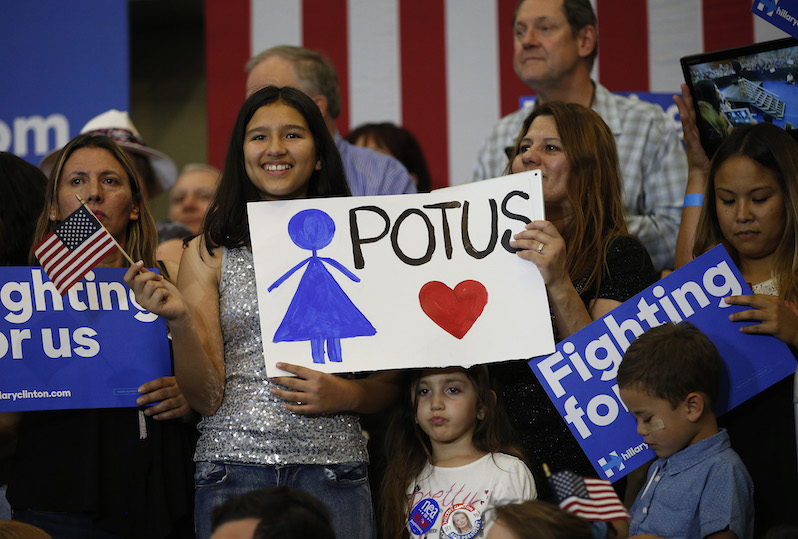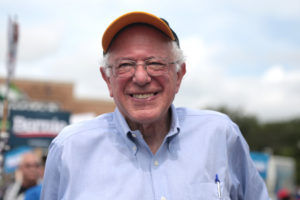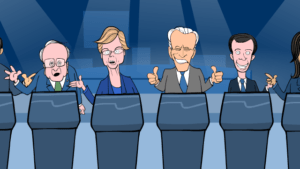These Blue-Collar College Students Vote for the United States
Interviews at one “working-class” school turn up distaste for both Hillary Clinton and Donald Trump but hope for the future. That optimism, however, is challenged by the poisonous campaign being fought for the presidency. Hillary Clinton supporters at a rally at California State University, San Bernardino, in June. (John Locher / AP)
Hillary Clinton supporters at a rally at California State University, San Bernardino, in June. (John Locher / AP)
Hillary Clinton supporters at a rally at California State University, San Bernardino, in June. (John Locher / AP)
Jennifer Green exemplifies the mixed emotions that the poisonous presidential election is causing among the young, who one day will be responsible for running the United States.
“It is an unfortunate campaign for both parties,” Green told me as we talked this week in the student union of California State University, San Bernardino.
I drove there looking for a cross section of opinion on the Donald Trump-Hillary Clinton election. While polls continue to show Clinton leading, the extreme negativity of their campaigns, combined with voter distaste for both candidates, calls for some caution in predicting the outcome of the race.
Until then, things are bound to get worse. Trump’s hiring of Stephen K. Bannon, boss of the radically right-wing Breitbart News, to run his campaign signals even more uninhibited attacks on Clinton over her emails, the Clinton Foundation, her speaking fees, her health — and let’s not forget the death of Vince Foster and Bill Clinton’s wayward sex life. As it is now shaping up, Clinton will reply in kind, painting the narcissistic Trump as unqualified and unstable.
I don’t like this campaign. I’d rather look back on good moments. I miss Bernie Sanders’ gruff but inspirational optimism. Listening to Trump and Clinton exchange vitriol, I yearn for another Jill Stein interview, listening as she earnestly explained every complex detail of her Green New Deal. Apparently afraid I might have missed something, she urged me to read academic studies on it.
Looking for a change, I thought I would go out and talk to voters.
Initially my goal was to find older, white, blue-collar industrial workers, supposedly the heart of Trump’s support, and see what’s bothering them. But such voters are tough to find in a state like California, where manufacturing is declining, the population is increasingly Latino, and whites are a minority. So rather than searching for the Trump constituency of older, white industrial workers in a dwindling number of factories, I looked for diversity and youth — millennials starting their climb up the challenging economic ladder.
I found them at California State University, San Bernardino, a working-class school with many students who are the first in their families to attend college. The campus is in what is called the Inland Empire, a 27,000-square-mile former agricultural area about a hundred miles east of Los Angeles. The student body—largely Latino and about 10 percent white, 7 percent Asian-American and 5 percent black—has worked hard to get there and to succeed in school. In addition to navigating classes, students have part-time jobs and have taken out student loans, and many take classes at night. The day I was there, the temperature was above 100 degrees, and the air was smoky from a huge brush fire in the nearby mountains. Cal State San Bernardino is no place for student dilettantes.
Green, 24, a white student who works part time giving tours at a local brewery, was at her laptop in the student union when I asked if she had time to talk about the election. She did.
“I’ve had many conversations about it with my peers,” said Green, who doesn’t especially like either of the candidates. “He [Trump] doesn’t have a strong position based on fact,” she said. “He is provoking to people and continues to get them upset and angry. … It’s almost like he encourages the masses to support him because he is the loudest person in the room.”
With Clinton, “it’s one thing after another about things she has done in the past, and a lot of it is incriminating.”
Green is majoring in international business and had favored Bernie Sanders. “He was more relatable to the younger generation. We were excited because there was a possibility for him assisting us through hard and difficult times.”
Her parents, on the other hand “are completely 100 percent lovers of Trump,” she said. Her father manages a home improvement store, and her mother is a paralegal. They like Trump, she said, because “he’s not politically correct, not afraid of saying what [he thinks] is right. They feel their opinions have been neglected” and that “the system is completely flawed.” She recently had lunch with her mother, who “gave me a 45-minute lecture on why I needed to vote for Trump.”
Patricia Horton, an African-American graduate student in counseling and guidance, told me, “Actually, it frightens me that Trump has gotten so far. I am not voting for Trump.” Clinton, she said, “has her things … but her husband was a pretty decent president.” Hillary Clinton spoke at the campus in May. Most students “were in awe. The fact that she came to our campus was a big deal.” But Horton, in the end, said, “I wish we could keep Obama until we find someone better.”
I talked to three freshmen: Fabian Jimenez, studying business; Kevin Lopez, a biology major; and Jacob Enriquez, an astronomy major.
Jimenez doesn’t like either candidate. Of Clinton, he said, “A girl running for president doesn’t show power. People won’t pay attention to her.”
Enriquez said, “I think it’s a joke [the election]. They want to do things for themselves, not for other people.”
In an office in the student union I met Maria Barragan, coordinator of Coyote Dreamers, the campus organization of Dreamers, the young immigrants who came here as children with their undocumented parents. The children grew up, enrolled in college and identify as Americans. (Cody the Coyote is Cal State San Bernardino’s mascot. By chance, “coyote” is also what smugglers who bring people across the U.S.-Mexico border are called.)
If Trump has his way, Barragan, who graduated last year with a degree in communications, would be on her way back to Guadalajara, Mexico, deported along with the rest of the United States’ 11 million undocumented immigrants.
“We tried to apply for a visa three times but were turned down,” she said. Barragan, only 9 at the time, remembered walking out of a U.S. consulate office in Mexico with her mother, two brothers and a sister. “It’s not going to happen,” her mother said. Her father was already in the United States. He and her mother arranged for the family to cross the border anyway.
“Growing up was really hard,” Barragan said. “Kids would make fun of me. I would wake up and throw up so I wouldn’t have to go to school.” Finally, a “teacher went out of his way to teach me English and buy me books.”
Although they don’t especially like the 2016 candidates, these young people seemed hopeful about the country and determined to get ahead. They are blue-collar students working hard for their educations and, later, their careers. Astronomy, business, biology, counseling and communications are their goals — all necessary for improving society.
Despite their skepticism about the political system, maybe some will try to find a way to make it work. I hope the current presidential campaign doesn’t poison the process for them.
Your support matters…Independent journalism is under threat and overshadowed by heavily funded mainstream media.
You can help level the playing field. Become a member.
Your tax-deductible contribution keeps us digging beneath the headlines to give you thought-provoking, investigative reporting and analysis that unearths what's really happening- without compromise.
Give today to support our courageous, independent journalists.






You need to be a supporter to comment.
There are currently no responses to this article.
Be the first to respond.